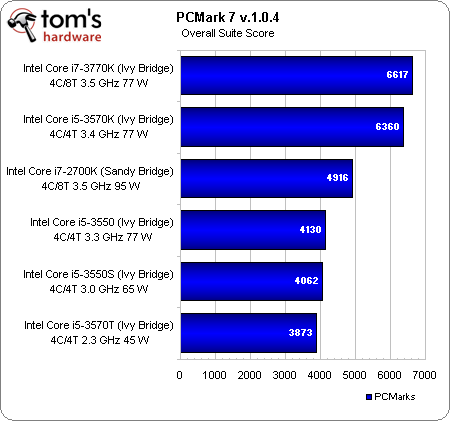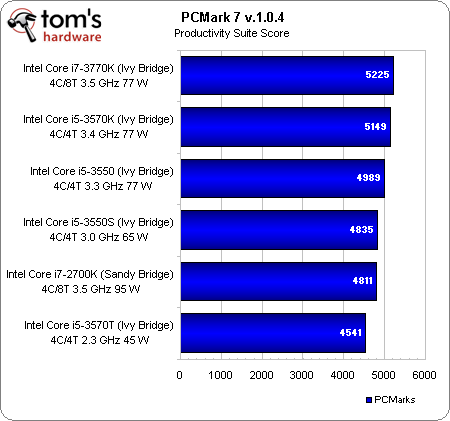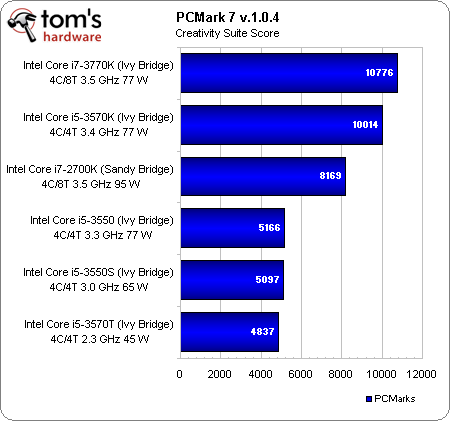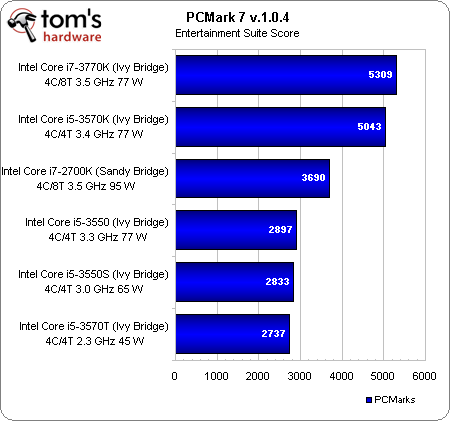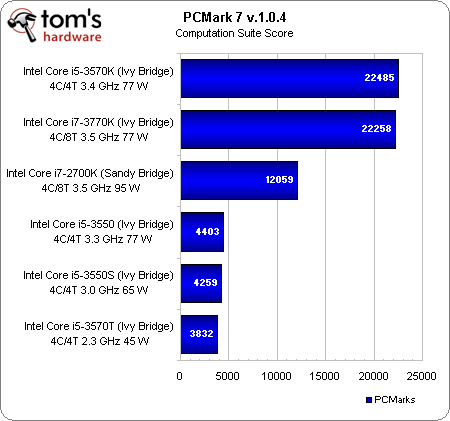Core i5-3570K, -3550, -3550S, And -3570T: Ivy Bridge Efficiency
After recommending Sandy Bridge last year, we weren't particularly impressed by the new Ivy Bridge-based Core i7-3770K as an upgrade. But are Intel's more mainstream third-gen Core i5 processors any more attractive? We grab four models to find out.
Benchmark Results: PCMark 7
It turns out that PCMark yields some of the most interesting results—and not necessarily in a good way.
If you flip back to the twelfth page of Intel Core i7-3770K Review: A Small Step Up For Ivy Bridge, you’ll notice that the Core i7-3770K scores here are higher than in that story. Moreover, the Core i5-3570K blows away the Core i7-2700K in this story and the launch coverage as well. What. The. Heck. Right? We were using a flippin’ GeForce GTX 680 for the launch, and basic HD Graphics 4000 here. You mean to tell me that, according to PCMark, the system with integrated graphics is better?
Let’s step through the sub-tests for more detail. We did some digging on this and have answers.
Alright. Productivity comes first, including Storage, Web browsing/decrypting, and Text editing components. Sandy Bridge winds up behind four different Ivy Bridge-based setups, three of which are Core i5s, and two of which employ HD Graphics 2500. It’s frankly difficult to imagine that this would reflect real-world performance, and we’ll keep these numbers in mind as we start firing up our own workloads.
Here’s where things start to get really wonky (though the oddest results are yet to come). Although the Creativity suite includes Storage, Image manipulation, and Video transcoding workloads, there’s a clear step down from HD Graphics 4000-, 3000-, and 2500-equipped CPUs.
Naturally, our first question was to Futuremark: is PCMark benefiting from Quick Sync? The company’s response: yes, using Microsoft’s Media Foundation transforms, hardware acceleration is utilized. Futuremark does not make public the weightings for each piece of the test, but it seems unlikely that one Quick Sync-enabled Ivy Bridge chip with HD Graphics 2500 should score less than half of a Quick Sync-enabled Ivy Bridge chip with HD Graphics 4000, particularly when transcoding is only one of three variables.
The Entertainment test is broader; it includes Video playback, Storage, Graphics, and Web browsing. All of these integrated graphics engines support DirectX 10, at least, so none of the tests are getting dropped. And yet, there’s still a huge gap between the top and bottom, clearly segmented by HD Graphics 4000, 3000, and 2500. We’ll simply have to accept that Graphics (gaming) and Video playback are the biggest determinants of performance in this one.
Get Tom's Hardware's best news and in-depth reviews, straight to your inbox.
Futuremark uses three pieces for its Computation suite: Video transcoding (downscaling), Video transcoding (high-quality), and Image manipulation. Not only does the test consequently suggest that the HD Graphics 4000-equipped processors are more than five times faster than the ones with HD Graphics 2500, but, again flipping back to Intel Core i7-3770K Review: A Small Step Up For Ivy Bridge, the benchmark puts a Core i5 almost four times above a Core i7-3960X-based machine with a GeForce GTX 680.
Bottom line: because PCMark is a black box, there’s no way to see how heavily Futuremark weighs video transcoding in its sub-tests. But judging by the disparity between Sandy Bridge and Ivy Bridge, the importance placed on Quick Sync is way too high. Will this benchmark show up again in the future? Probably, but more selectively, now that we know any fixed-function transcode acceleration can throw off its results so blatantly.
Current page: Benchmark Results: PCMark 7
Prev Page Test Setup And Benchmarks Next Page Benchmark Results: SiSoft Sandra 2012-
erraticfocus nice work in sorting out the facts and reminding us about the history and change from the lower power offerings in the intel stable..Reply
-
amdfangirl Does Intel allow underclocking and undervolting on H-series boards? If so, S and T series are pretty redundant.Reply -
Onikage 2700K looks a clear Winner to me ! got one last week from Microcenter at an ironic but sensational price 270$ !!!! hey 3770K try and beat that !Reply -
Outlander_04 In the real world gaming section you got a great big graph for the 3770k by adding a discreet graphics card . Why didn't you try a Llano system with an identical graphics card? Afraid the second tier AMD product would kick sand in intels face?Reply -
cangelini Outlander_04In the real world gaming section you got a great big graph for the 3770k by adding a discreet graphics card . Why didn't you try a Llano system with an identical graphics card? Afraid the second tier AMD product would kick sand in intels face?Because this is a story about the Intel chips. To the contrary, though, the AMD-based platform is more likely to bottleneck a discrete graphics card than the Intel one. AMD's strength is in the integrated graphics right now.Reply -
Outlander_04 The performance of a Llano chip is included in the article to compare its performance so it not just about intel cpu's . The intels were not as good in gaming in the integrated graphics so a graphics card was added so they'd look better there too . Its an unfair comparison and shows intel bias IMOReply -
jimmysmitty Outlander_04The performance of a Llano chip is included in the article to compare its performance so it not just about intel cpu's . The intels were not as good in gaming in the integrated graphics so a graphics card was added so they'd look better there too . Its an unfair comparison and shows intel bias IMOReply
Actually a lot of sites have shown just what Chris is talking about. Even a dual core Pentium with a HD6670 beats the top end Llano piece (a quad core) even with CFX of the IGP with a HD6570. Llano is great for some things but overall in DT its only a low end entry level product and is much weaker per core and per clock than Intels CPUs.
What Chris did was pulled the same charts from his first IB review and added in the HD2500 (the new low end Intel IGP) for comparison.
If someone cannot take this information and realize that its just for comparison and that its not to show anything better, then thats their problem. If this was a Llano article, or the Trinity article when it comes out, you better believe Chris will do everything to check ever performance aspect. But its not. Its an article to see if the T and S models are worth it.
Overll, llano is overrate in my book. We have barley sold any at my work place. Just doesn't have the pulling power like a CPU and discrete GPU does. -
Outlander_04 If you are going to show the performance of an intel cpu with a graphics card then any reasonable comparison would also show the AMD cpu with the same graphics card .Reply
